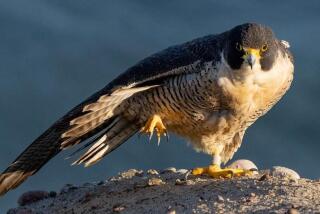Peregrine Falcon Breeding Project Hailed : Wildlife: The once-endangered predatory bird has recovered so well that captive procreation program will be stopped.
- Share via
In what biologists hailed as “a wonderful success story,” the once-endangered American peregrine falcon that was decimated by DDT in the 1960s has made such a dramatic comeback that a 17-year-old captive breeding project is being ended.
The birds, famous for their use in falconry and identified by their distinctive gray or black “helmet,” were down to two known mating pairs in 1975.
But a captive breeding program sponsored by the Predatory Bird Research Group based at UC Santa Cruz has restored the population to at least 120 mating pairs.
“We feel it’s a wonderful success story,” said wildlife biologist Janet Linthicum by telephone from Santa Cruz. The group has released more than 700 chicks into the wild since 1975, most of them in California.
Word of the falcon’s revival came just days before the U.S. Fish and Wildlife Service is scheduled to release several California condors into the wild. The condors, bred in captivity at the San Diego Wild Animal Park and the Los Angeles Zoo, were returned to the Sespe wilderness of Ventura County late last year. But they have been kept in an enclosed nesting site. Next week, plans call for their first free flight into the wild.
During the 1960s the peregrine--which can dive at speeds of more than 200 m.p.h.--was nearly wiped out by the pesticide DDT, which accumulated in their prey and weakened the eggshells of the birds’ offspring. A year after DDT was banned in the United States in 1972, the peregrine was placed on the endangered species list.
After the final egg hatching this spring, Linthicum said the captive breeding program will be stopped.
“We hope that they’ll be able to maintain themselves despite the remaining DDT in the environment. But, it will take a lot of monitoring of the bird population to make sure that’s the case,” she said.
Joining in the monitoring will be the California Fish and Game Department, U.S. Fish and Wildlife Service, U.S. Bureau of Land Management and U.S. Forest Service.
Linthicum noted that several pairs of wild peregrines live in downtown Los Angeles, Long Beach and the La Brea tar pits.
More to Read
Sign up for Essential California
The most important California stories and recommendations in your inbox every morning.
You may occasionally receive promotional content from the Los Angeles Times.










